They've been a long time
coming...
 It
was two years in the planning, but they finally did it! Canada has finally put together a
National Championship program. The Agility Association of Canada (AAC) held it's first ever
National Championship at Spruce Meadows Equestrian Centre in Calgary Alberta on 1-2 September
2001. It included a Power & Speed course designed by our own Jo Rhodes. By all accounts, it was
well worth the wait. Kim Collins explains how it worked. It
was two years in the planning, but they finally did it! Canada has finally put together a
National Championship program. The Agility Association of Canada (AAC) held it's first ever
National Championship at Spruce Meadows Equestrian Centre in Calgary Alberta on 1-2 September
2001. It included a Power & Speed course designed by our own Jo Rhodes. By all accounts, it was
well worth the wait. Kim Collins explains how it worked.
The road to the
Nationals started last March when the first of seven Regional Championship Qualifiers were held
across Canada. Dogs from each AAC Region who had earned 300 points or more at their regional
were invited to attend the National Championship.
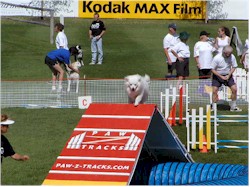 This
is how it all worked… This
is how it all worked…
Because our Titling System in AAC - much like USDAA - requires dogs to excel in all aspects of
the sport, we felt that in order to find the top dogs, we needed to include Gamblers and
Jumpers classes as part of the overall picture. So each dog and handler team had to run two
Standard rounds, two Gamblers rounds and two Jumpers rounds at both the Regionals and
Nationals.
In Standard rounds
the emphasis was on handling and obstacle performance with bonus points for all seconds under
standard course time (SCT). The round had to be fault free to earn the bonus points. Standard
rounds were based on a total 100 points so if a dog runs clean and 20 seconds under SCT, it
would earn 120 points. If a dog runs 20 seconds under SCT but has five faults, it would earn a
score of 95 points for that round.
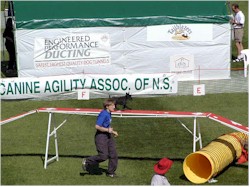 In
the Gamblers rounds a successful Gamble was awarded 35 bonus points which is added to your
opening points. If you do not complete the gamble, you keep your opening points only. There was
no doubling of opening points. In
the Gamblers rounds a successful Gamble was awarded 35 bonus points which is added to your
opening points. If you do not complete the gamble, you keep your opening points only. There was
no doubling of opening points.
Jumpers was scored
the same as the Standard with bonus points for under SCT, fault free.
Faults were based on
AAC Masters rules with minor changes. Off course was 20 faults - not an immediate elimination,
and all refusals were faulted. There were no maximum faults. This system worked great in that
it did not eliminate a dog from the competition for a 5-fault run.
Every dog entered
was guaranteed to run six rounds over the two days. The competition was not over until the last
dog ran, so the suspense was great. Everyone knew at the end of Saturday where they ranked, and
they knew what they had to do to move up. Clearly the pressure was on for every round to run
fast and clean.
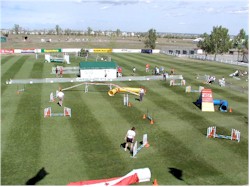 International
input International
input
We also did something slightly different for both
the Regionals and the Nationals in our course design and selection. Any AAC Advanced and
Masters level judge could submit courses for use at the Regional level and any Masters level
judge from any organization and from any place in the world could submit courses for the
Nationals. We had submissions from Canada, the US and England for our Nationals.
This approach met
with a bit of controversy before the first Regional but the participating judges had no
problems with it and felt they got some good ideas about different course design from judging
someone else’s courses. Of the judges who were not in favor - and there were only a few - none
actually participated in the events. I noticed the judges at the USDAA Nationals this year
judged other people’s courses quite often and I think they still felt honored to be there, and
they did a fabulous job!
The courses were
also selected by random draw on the morning of the trial. They were all in sealed blank
envelopes and a competitor was asked to come up and select an envelope of their choice, sort of
a 'what’s behind door # 3?' thing. It was great! The competitors loved it as they got a chance
to run on courses designed by judges they might never otherwise run under. It also gave clubs
some insight into new judges they had never hired before. It eliminated the problem of clubs
hiring judges for their Regionals because they have notoriously 'easy' courses, or because the
courses they design suit a particular style of dog. It also leveled the playing field all over
the country.
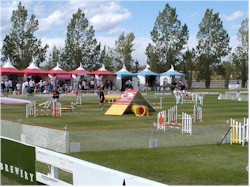 The
decision to allow International judges to submit courses and also to judge at the Nationals was
also a bit of a controversy as people said that it would not be a truly Canadian event.
However, it was decided that because anyone could register their dog with AAC and compete, it
should not be restricted in any other way either. It was also felt that because AAC is one of
the younger Associations, it was time we started seeing and participating in a more global form
of agility. Allowing courses and judges from outside our Association, would help open up
opportunities for Canadians to experience different styles of courses and handling techniques
required to get through those courses successfully. The
decision to allow International judges to submit courses and also to judge at the Nationals was
also a bit of a controversy as people said that it would not be a truly Canadian event.
However, it was decided that because anyone could register their dog with AAC and compete, it
should not be restricted in any other way either. It was also felt that because AAC is one of
the younger Associations, it was time we started seeing and participating in a more global form
of agility. Allowing courses and judges from outside our Association, would help open up
opportunities for Canadians to experience different styles of courses and handling techniques
required to get through those courses successfully.
The event
There were 172 dogs entered this year with all
dogs (Regular, Specials and Veterans) being acknowledged and treated equally. We ran three
rings, and because of the way we ran them there were no ring conflicts and things ran very
quickly and smoothly. Each ring was labeled Red, Green or Blue and handlers were assigned a
group either A, B or C on their confirmation. Someone running multiple dogs, regardless
of height, always ran in the same ring. So I had a 22” Regular dog and a 10” Specials dog, I
was assigned to Group C. I ran Gamblers in the Blue ring, then moved to Jumpers in the Red ring
and Standard in the Green ring.
The rings remained
static with one course set in each ring all. The groups A, B and C rotated from ring to
ring. All course walk throughs were 'shotgun' starts so every ring had to be completely done
before the next walk through started. Walk throughs were split into 22” and 26” Regular dogs
walking first for their ten minutes, and then all the Mini’s, Specials and Vets next. This
format worked so well that we were done by about 3:45pm on Saturday without rushing people
through or eliminating dogs for minimal faults. It was very relaxed and calm.
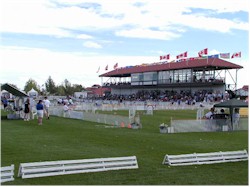 A
great venue A
great venue
And last but certainly not least I need to mention the site. Spruce Meadows is ranked one
of the most beautiful Equine Center’s in the world. It is blessed with beautifully groomed
lawns, covered barns for crating, huge parking lots, covered grand stands, loads of room for
vendor tents, ample bathrooms, all the decorations we could ever want to make the site look
great for photo’s, concession, large sand ring for exercising the dogs and a formal dining room
with balcony overlooking one of the many grand horse jumping rings for our banquet, all made
this site special.
A great show!
All in the entire event was a huge success. It was great to show up at the USDAA Nationals and
have people say they heard how well our Nationals went. Thanks to those who have supported the
event either as a volunteer or a competitor. We hope to be able to continue in the footsteps of
the USDAA, NADAC and AKC to promote excellence in the sport of agility in North America and
encourage people to grow and learn as handlers, trainers, spectators, judges and companions of
our very special furry friends!
Results were as
follows:
|
Class |
Handler |
Dog |
Breed |
Province |
| 10”
Regular |
Susan
Garrett |
Twister |
JRT |
Ontario |
| 16”
Regular |
Shirley
McRitchie |
Caity |
American Eskimo |
Ontario |
| 22”
Regular |
Annette
Hoegl |
Asti |
Border
Collie |
Ontario |
| 26”
Regular |
Susan
Garrett |
Buzz |
Border
Collie |
Ontario |
| 6”
Specials |
Julia
Beaton |
Finnigan |
Papillion |
British
Columbia |
| 10”
Specials |
Kim
Collins |
Piper |
Shetland Sheepdog |
British
Columbia |
| 16”
Specials |
Pat
Eckland |
Riley |
Nova
Scotia Duck Toller |
British
Columbia |
| 22”
Specials |
Bev
Mattson |
Flora |
Bernese
Mountain Dog |
British
Columbia |
| 6”
Veterans |
Mary
Zacharatos |
Duffy |
West
Highland White Terrier |
British
Columbia |
| 10”
Veterans |
Valerie
Hooper |
Missie |
Shetland Sheepdog |
Ontario |
| 16”
Veterans |
Joyce
Blackburn |
Prunelle |
Shetland
Sheepdog |
Quebec |
| 22”
Veterans |
Jim
Mills |
Ranger |
Border
Collie |
Alberta |
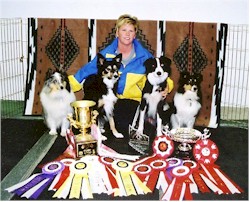 About
the author... About
the author...
Kim Collins is the Agility Director for Top Dog Agility, Obedience and Flyball
Association in Prince George, BC, Canada. She teaches agility classes and seminars and
is an AAC Masters level judge. She is the AAC Nationals Chairperson. Kim runs three of
her four dogs in competition, Ceildhe is retired.
Her Sheltie Piper
was the first Mini dog to earn the AAC title Agility Trial Champion, her Border Collie Bryn
also holds the AAC title of Agility Trial Champion, as well as being, to date, the dog who
earned the Master Agility Dog of Canada title the fastest in AAC history ( 49 days ) and also
holds the record for being the dog who earned the ATChC title the fastest (8 months) and is the
youngest dog to earn that title in AAC.
Kim competes in AAC,
USDAA and NADAC agility with all of her dogs. Piper won the 16” height class at the 2000 USDAA
Grand Prix National Championships and won the 10” Specials class in the 2001 AAC Nationals.
Bryn was a finalist in the 2000 USDAA Grand prix and placed fourth in the 22” class in the AAC
Nationals in 2001.
Feedback
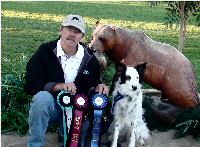 From
Dave Steinman & Blue... From
Dave Steinman & Blue...
I was linked to your
site while visiting sites about deaf dogs. As you guessed I have a deaf dog Blue is my agility
partner and my best friend. Blue and I enjoy reading about agility in other places.
The reason for my email is when I went to your international page
Agility in the America's - North, South and in between. I was truly impressed you had a page
about agility in Canada - the AAC and another about
their 1st nationals event.
You might want to update your info though as this coming August
will be AAC's 11th national event, but please do not remove the existing info as that info like
this may not be archived anywhere else.
Last year was AAC Nationals 10th anniversary and it was held at
Spruce Meadows, the same venue as the first Nationals. Blue and i had a great time and she
placed 14th overall out of the 55 dogs in her class. She was the only dea fdog competing.
Agility in Canada as everywhere has really grown there must be
over 3000 members in AAC now. At last years Nationals there was 650 dogs that had entered.
(19/07/11)
|  About
the author...
About
the author... From
Dave Steinman & Blue...
From
Dave Steinman & Blue...